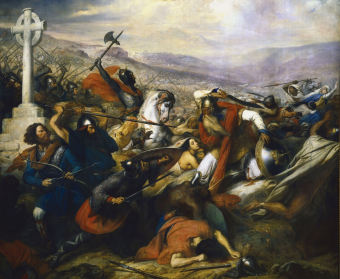This Day in History: October 10th- The Battle That Shaped History
This Day In History: October 10, 732 C.E.
 The Battles of Tours was not a war of nations, but rather a battle of civilizations between Islam and Christian Europe. The Muslims had been conquering the remains of the Roman and Persian empires and were heading toward modern day France to continue their expansion. The Frankish King Charles (“The Hammer”) Martel wasn’t about to let that happen, so he gathered his forces at Tours as Abdul Rahman Al Ghafiqi, Governor-General of Moorish Spain, led his Army northward.
The Battles of Tours was not a war of nations, but rather a battle of civilizations between Islam and Christian Europe. The Muslims had been conquering the remains of the Roman and Persian empires and were heading toward modern day France to continue their expansion. The Frankish King Charles (“The Hammer”) Martel wasn’t about to let that happen, so he gathered his forces at Tours as Abdul Rahman Al Ghafiqi, Governor-General of Moorish Spain, led his Army northward.
The army that Charles amassed was very different from the Arab fighting forces. It was also unlike the Barbarian horde the Muslims had engaged the last time they attacked the area, and had no doubt had expected to encounter again. Previously, the only thing standing between a Frankish soldier and death was a heavy shield – they were now sporting full body armor. Their army boasted a full infantry unit that was quite a contrast to the lightly armed Arab horsemen who relied upon their speed, mobility and fearsomeness to win the field.
Martel also benefited from the element of surprise, as he knew Rahman’s position but the Moors were unaware that the Franks were closing in on them. Martel positioned his forces where they could not be bypassed, drew them into an infantry square and had them lock shields, leaving the Moors in a crummy position. For a full week, aside from the occasional skirmish, the two armies had a staring contest. Finally on day seven Rahman ordered an attack.
Since horses often have more sense than people and won’t charge a solid wall of spears and swords, the Moors could only ride up, fire an arrow or toss a javelin or two, and then gallop away. The Franks, protected behind their wall of steel, countered by hacking the stuffing out of anyone that came up on them, racking up high causalities among the lightly armored enemy.
During one of those charges, Moorish leader Abdul Rahman Al Ghafiq was killed when he was trying to restore order to his soldiers who were paying more attention to protecting their plunder than the battle. The Islamic army retreated south later that same night.
Most modern historians believe that Martel’s victory at Tours shaped the course of Western Europe. Had the Franks fallen to the Moors, there was no other power in existence at the time capable of containing Islam’s spread, meaning there would have been no Charlemagne (Martel’s grandson) or Holy Roman Empire. Christianity and Europe as we know it today may have hinged on that one battle.
In addition to changing the course of Western civilization, Martel’s brilliant strategic military mind and his ability to coordinate cavalry and infantry enabled him to beat the much larger Islamic army. The Battle of Tours marked the first time a European force of heavy infantry defeated a Moorish cavalry army, and established the Franks as the premier military power in Europe for years to come.
If you liked this article, you might also enjoy our new popular podcast, The BrainFood Show (iTunes, Spotify, Google Play Music, Feed), as well as:
- The Huguenots vs. the French Catholics: The St. Bartholomew’s Day Massacre
- Why the French-Founded Notre Dame School’s Athletic Teams are the “Fighting Irish”
- Jan Zizka: The General Who Had His Skin Turned Into a Drum
- What Started World War I
| Share the Knowledge! |
|





“Moorish Spain”
In the year 752′ that was doggone near all of modern Spain. It had been conquered and occupied by the Moors following the collapse of Roman power in Iberia.
In fact, the Moorish (Muslim) occupation of Spain lasted for more than 700 years, until 1492. Remember that, next time you hear a Muslim complain about the Christian Crusades.
And next time you hear a Muslim insist that “al Andaluz” rightfully belongs to the Muslim Caliphate, remember that they are talking about Spain. They want it back – AS IF it belongs to them.
Charles Martel was not the king. He was steward of the palace.
Kudos, Robin, for correcting Martel’s status. Meanwhile, I must clarify John’s comment about pre-Islamic Iberia. The Romans were long gone from present-day Spain when the Moorish invasion occurred. The Muslims actually took the land from the Visigoths, who reputedly had a heavily Romanized civilization.
A couple of clarifications. First, you have “Charles ‘ The Hammer’ Martel”, as though Martel were his last name. It is actually the old Frankish word meaning ‘hammer’, so that was his nickname, The Hammer. The Frankish, like most peoples of the world then, did not use ‘family names’ in the way we do today. For example, his father was called Pepin of Heristal, and many were either distinguished by their place or origin or by their father (i.e., ‘son of’, which has many forms in many countries), or by their nickname (e.g., Charles’ son was called ‘Pepin the Younger’ or ‘Pepin the Short’).
Next, Charles’ actual title was Major Duomo, or Mayor of the Palace, not steward. However, Pepin had taken the titles of Duke of Austrasia and Prince of Francia, and he held the actual power, not the king, so it is not inaccurate to call Charles the ruler of Francia regardless of his title (he kept a puppet king for authority for most of his reign).
There are other minor errors here, but you have the gist of what went on. Good for you!